What Is Sociology? | American Sociological Association
VerifiedAdded on 2022/08/24
|10
|2221
|24
AI Summary
Contribute Materials
Your contribution can guide someone’s learning journey. Share your
documents today.
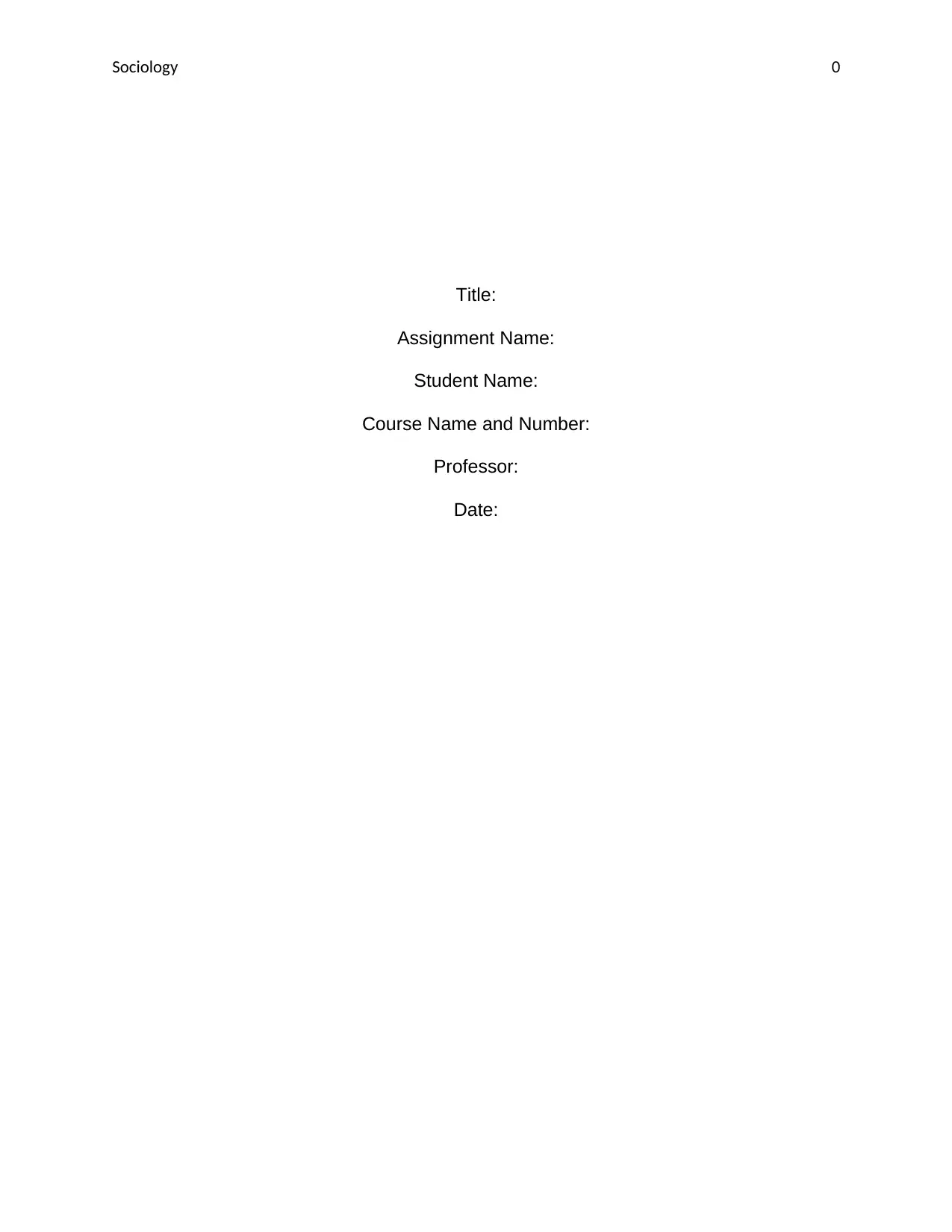
Sociology 0
Title:
Assignment Name:
Student Name:
Course Name and Number:
Professor:
Date:
Title:
Assignment Name:
Student Name:
Course Name and Number:
Professor:
Date:
Secure Best Marks with AI Grader
Need help grading? Try our AI Grader for instant feedback on your assignments.

Sociology 1
Table of Contents
Philosophy statement........................................................................................................1
Influential Philosophers and Theorists (2 pages)..............................................................2
Personal and Professional Experiences (2 pages)...........................................................4
Operationalization..............................................................................................................5
References.........................................................................................................................7
Philosophy statement
Children have eyes full of pure innocence and a mind full of notoriousness. This is the
one quality that drove me towards becoming a child educator. Working with them over a
Table of Contents
Philosophy statement........................................................................................................1
Influential Philosophers and Theorists (2 pages)..............................................................2
Personal and Professional Experiences (2 pages)...........................................................4
Operationalization..............................................................................................................5
References.........................................................................................................................7
Philosophy statement
Children have eyes full of pure innocence and a mind full of notoriousness. This is the
one quality that drove me towards becoming a child educator. Working with them over a
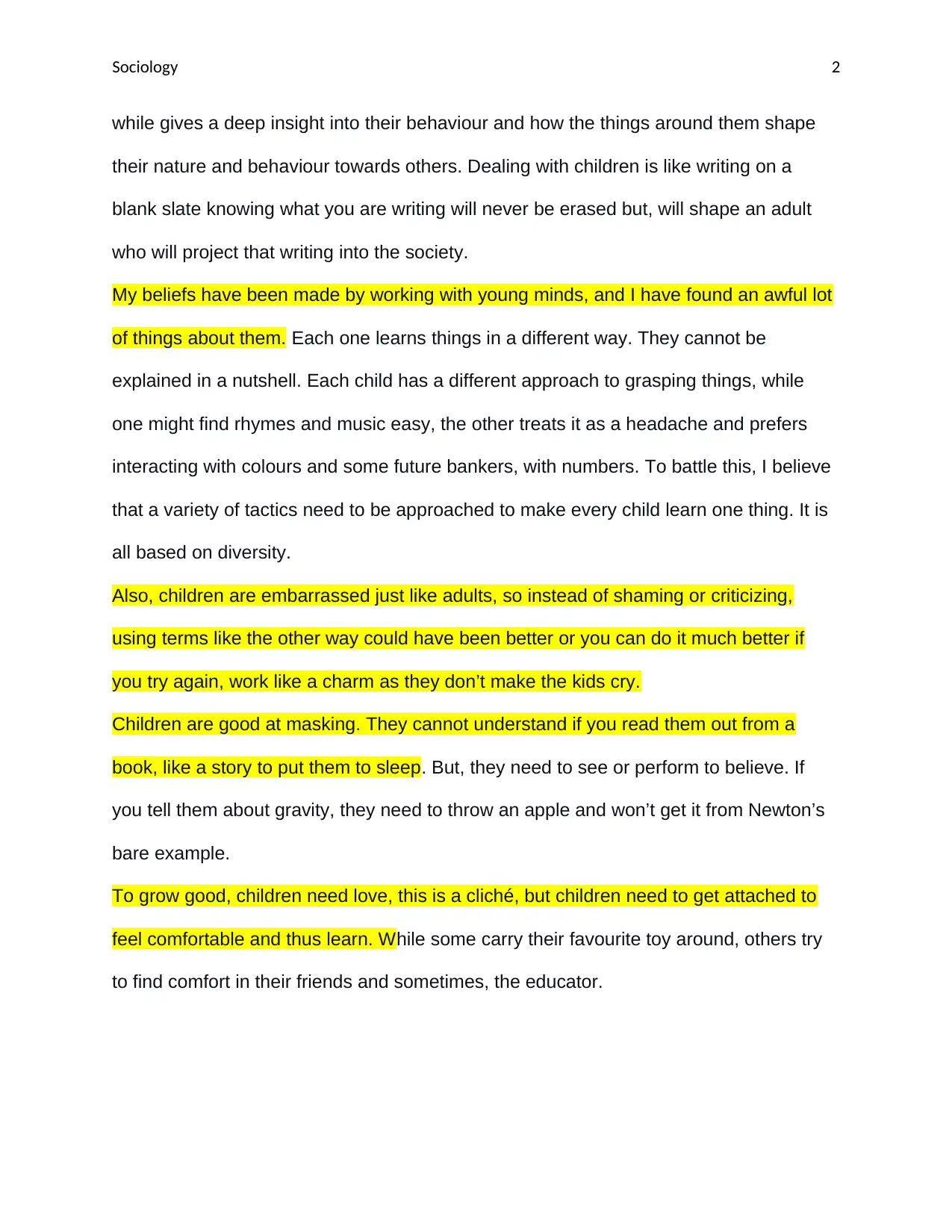
Sociology 2
while gives a deep insight into their behaviour and how the things around them shape
their nature and behaviour towards others. Dealing with children is like writing on a
blank slate knowing what you are writing will never be erased but, will shape an adult
who will project that writing into the society.
My beliefs have been made by working with young minds, and I have found an awful lot
of things about them. Each one learns things in a different way. They cannot be
explained in a nutshell. Each child has a different approach to grasping things, while
one might find rhymes and music easy, the other treats it as a headache and prefers
interacting with colours and some future bankers, with numbers. To battle this, I believe
that a variety of tactics need to be approached to make every child learn one thing. It is
all based on diversity.
Also, children are embarrassed just like adults, so instead of shaming or criticizing,
using terms like the other way could have been better or you can do it much better if
you try again, work like a charm as they don’t make the kids cry.
Children are good at masking. They cannot understand if you read them out from a
book, like a story to put them to sleep. But, they need to see or perform to believe. If
you tell them about gravity, they need to throw an apple and won’t get it from Newton’s
bare example.
To grow good, children need love, this is a cliché, but children need to get attached to
feel comfortable and thus learn. While some carry their favourite toy around, others try
to find comfort in their friends and sometimes, the educator.
while gives a deep insight into their behaviour and how the things around them shape
their nature and behaviour towards others. Dealing with children is like writing on a
blank slate knowing what you are writing will never be erased but, will shape an adult
who will project that writing into the society.
My beliefs have been made by working with young minds, and I have found an awful lot
of things about them. Each one learns things in a different way. They cannot be
explained in a nutshell. Each child has a different approach to grasping things, while
one might find rhymes and music easy, the other treats it as a headache and prefers
interacting with colours and some future bankers, with numbers. To battle this, I believe
that a variety of tactics need to be approached to make every child learn one thing. It is
all based on diversity.
Also, children are embarrassed just like adults, so instead of shaming or criticizing,
using terms like the other way could have been better or you can do it much better if
you try again, work like a charm as they don’t make the kids cry.
Children are good at masking. They cannot understand if you read them out from a
book, like a story to put them to sleep. But, they need to see or perform to believe. If
you tell them about gravity, they need to throw an apple and won’t get it from Newton’s
bare example.
To grow good, children need love, this is a cliché, but children need to get attached to
feel comfortable and thus learn. While some carry their favourite toy around, others try
to find comfort in their friends and sometimes, the educator.
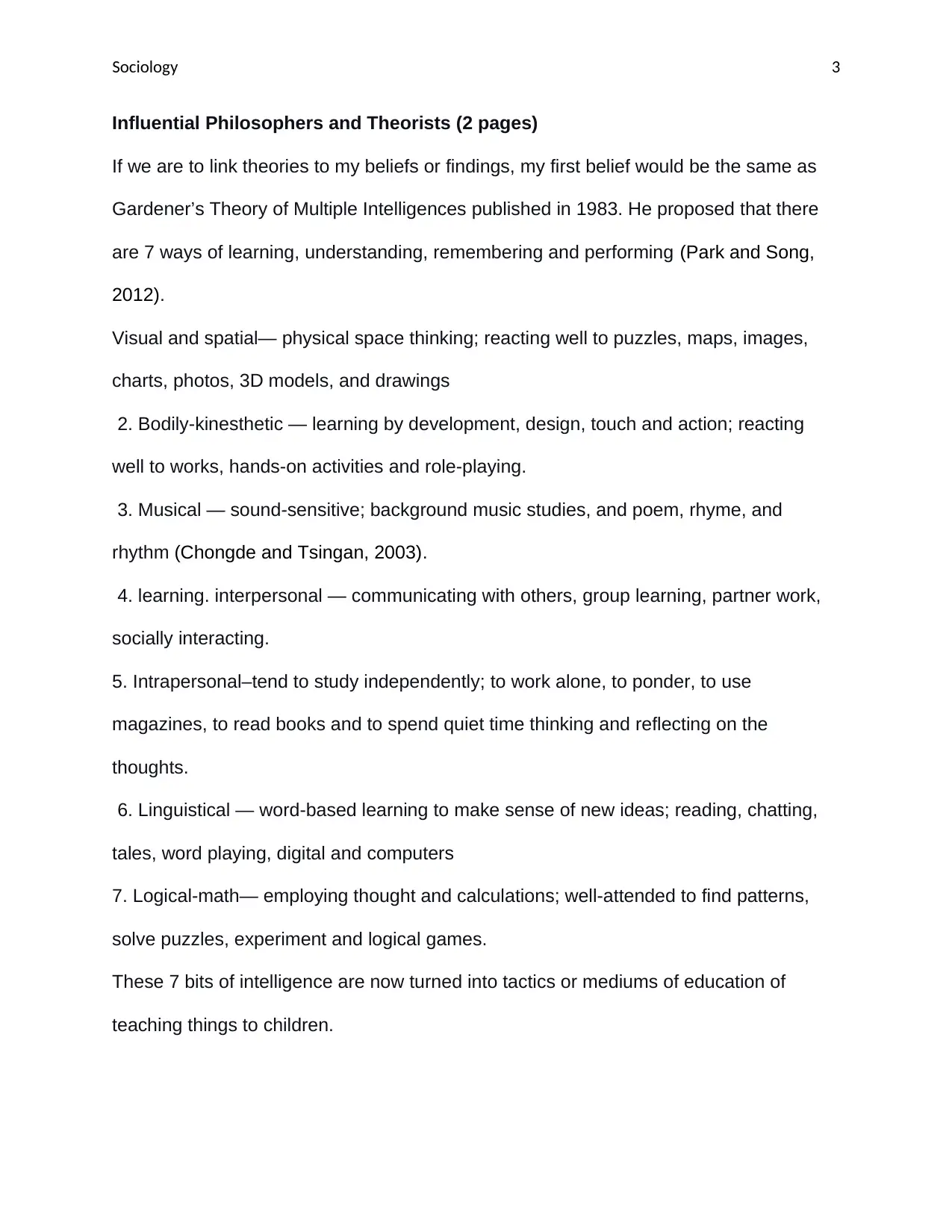
Sociology 3
Influential Philosophers and Theorists (2 pages)
If we are to link theories to my beliefs or findings, my first belief would be the same as
Gardener’s Theory of Multiple Intelligences published in 1983. He proposed that there
are 7 ways of learning, understanding, remembering and performing (Park and Song,
2012).
Visual and spatial— physical space thinking; reacting well to puzzles, maps, images,
charts, photos, 3D models, and drawings
2. Bodily-kinesthetic — learning by development, design, touch and action; reacting
well to works, hands-on activities and role-playing.
3. Musical — sound-sensitive; background music studies, and poem, rhyme, and
rhythm (Chongde and Tsingan, 2003).
4. learning. interpersonal — communicating with others, group learning, partner work,
socially interacting.
5. Intrapersonal–tend to study independently; to work alone, to ponder, to use
magazines, to read books and to spend quiet time thinking and reflecting on the
thoughts.
6. Linguistical — word-based learning to make sense of new ideas; reading, chatting,
tales, word playing, digital and computers
7. Logical-math— employing thought and calculations; well-attended to find patterns,
solve puzzles, experiment and logical games.
These 7 bits of intelligence are now turned into tactics or mediums of education of
teaching things to children.
Influential Philosophers and Theorists (2 pages)
If we are to link theories to my beliefs or findings, my first belief would be the same as
Gardener’s Theory of Multiple Intelligences published in 1983. He proposed that there
are 7 ways of learning, understanding, remembering and performing (Park and Song,
2012).
Visual and spatial— physical space thinking; reacting well to puzzles, maps, images,
charts, photos, 3D models, and drawings
2. Bodily-kinesthetic — learning by development, design, touch and action; reacting
well to works, hands-on activities and role-playing.
3. Musical — sound-sensitive; background music studies, and poem, rhyme, and
rhythm (Chongde and Tsingan, 2003).
4. learning. interpersonal — communicating with others, group learning, partner work,
socially interacting.
5. Intrapersonal–tend to study independently; to work alone, to ponder, to use
magazines, to read books and to spend quiet time thinking and reflecting on the
thoughts.
6. Linguistical — word-based learning to make sense of new ideas; reading, chatting,
tales, word playing, digital and computers
7. Logical-math— employing thought and calculations; well-attended to find patterns,
solve puzzles, experiment and logical games.
These 7 bits of intelligence are now turned into tactics or mediums of education of
teaching things to children.
Secure Best Marks with AI Grader
Need help grading? Try our AI Grader for instant feedback on your assignments.
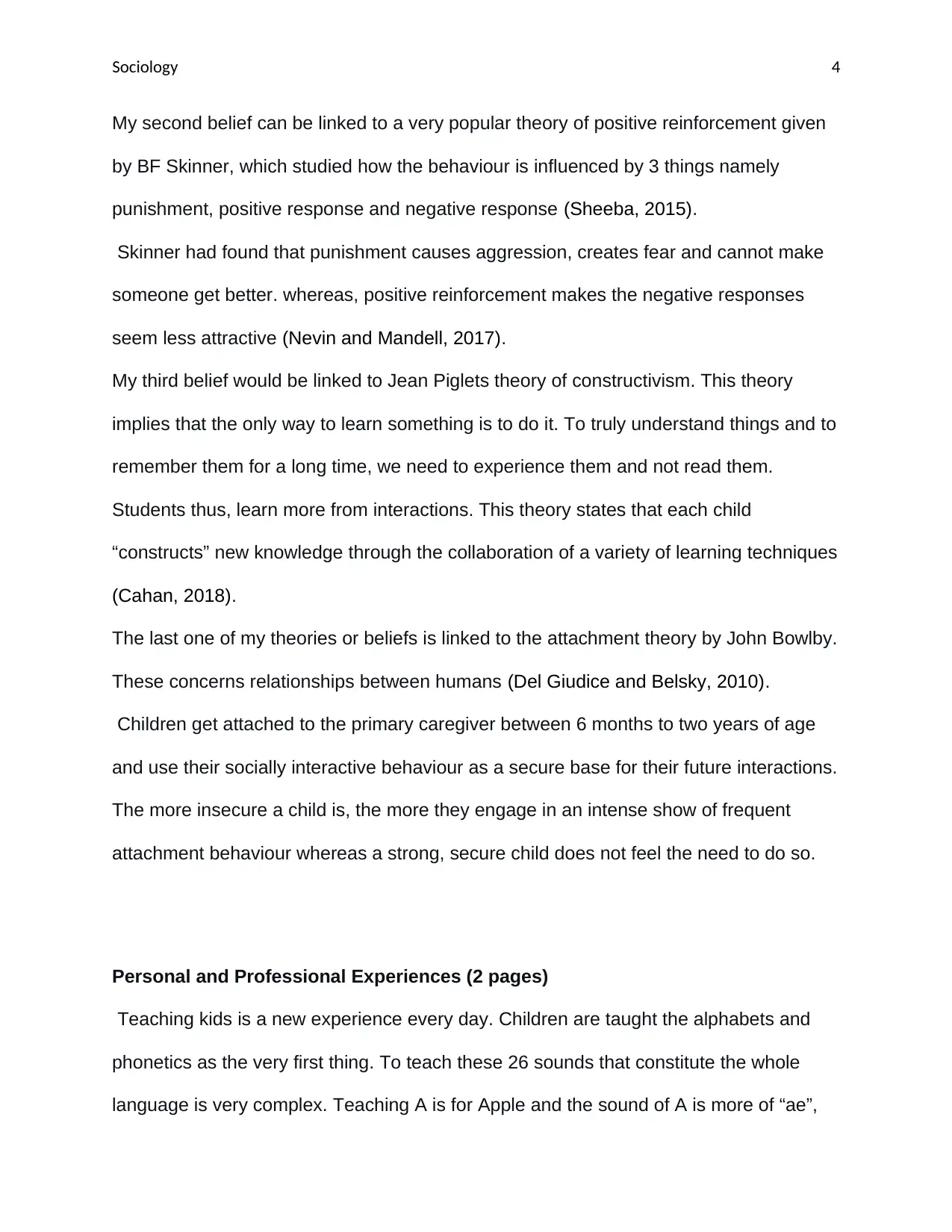
Sociology 4
My second belief can be linked to a very popular theory of positive reinforcement given
by BF Skinner, which studied how the behaviour is influenced by 3 things namely
punishment, positive response and negative response (Sheeba, 2015).
Skinner had found that punishment causes aggression, creates fear and cannot make
someone get better. whereas, positive reinforcement makes the negative responses
seem less attractive (Nevin and Mandell, 2017).
My third belief would be linked to Jean Piglets theory of constructivism. This theory
implies that the only way to learn something is to do it. To truly understand things and to
remember them for a long time, we need to experience them and not read them.
Students thus, learn more from interactions. This theory states that each child
“constructs” new knowledge through the collaboration of a variety of learning techniques
(Cahan, 2018).
The last one of my theories or beliefs is linked to the attachment theory by John Bowlby.
These concerns relationships between humans (Del Giudice and Belsky, 2010).
Children get attached to the primary caregiver between 6 months to two years of age
and use their socially interactive behaviour as a secure base for their future interactions.
The more insecure a child is, the more they engage in an intense show of frequent
attachment behaviour whereas a strong, secure child does not feel the need to do so.
Personal and Professional Experiences (2 pages)
Teaching kids is a new experience every day. Children are taught the alphabets and
phonetics as the very first thing. To teach these 26 sounds that constitute the whole
language is very complex. Teaching A is for Apple and the sound of A is more of “ae”,
My second belief can be linked to a very popular theory of positive reinforcement given
by BF Skinner, which studied how the behaviour is influenced by 3 things namely
punishment, positive response and negative response (Sheeba, 2015).
Skinner had found that punishment causes aggression, creates fear and cannot make
someone get better. whereas, positive reinforcement makes the negative responses
seem less attractive (Nevin and Mandell, 2017).
My third belief would be linked to Jean Piglets theory of constructivism. This theory
implies that the only way to learn something is to do it. To truly understand things and to
remember them for a long time, we need to experience them and not read them.
Students thus, learn more from interactions. This theory states that each child
“constructs” new knowledge through the collaboration of a variety of learning techniques
(Cahan, 2018).
The last one of my theories or beliefs is linked to the attachment theory by John Bowlby.
These concerns relationships between humans (Del Giudice and Belsky, 2010).
Children get attached to the primary caregiver between 6 months to two years of age
and use their socially interactive behaviour as a secure base for their future interactions.
The more insecure a child is, the more they engage in an intense show of frequent
attachment behaviour whereas a strong, secure child does not feel the need to do so.
Personal and Professional Experiences (2 pages)
Teaching kids is a new experience every day. Children are taught the alphabets and
phonetics as the very first thing. To teach these 26 sounds that constitute the whole
language is very complex. Teaching A is for Apple and the sound of A is more of “ae”,
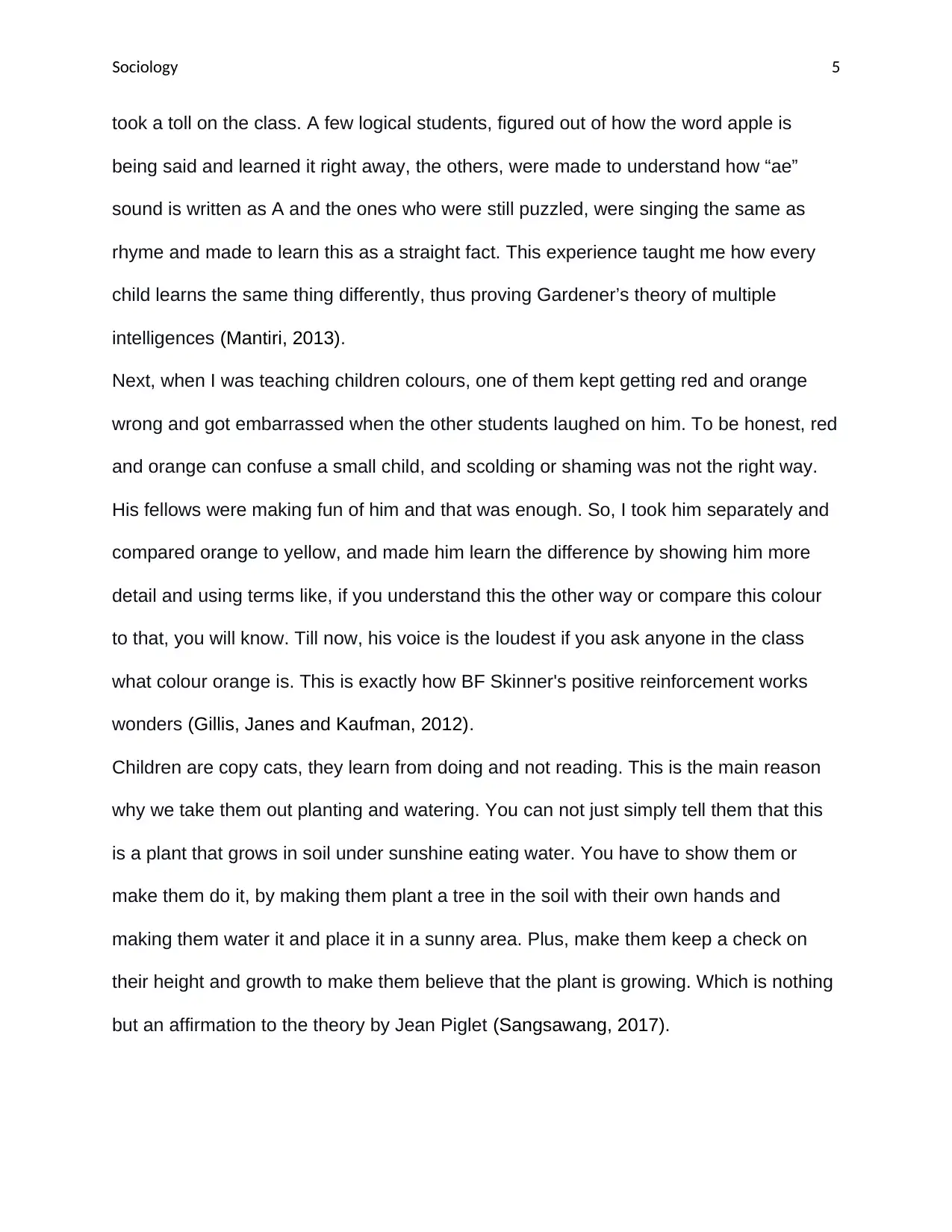
Sociology 5
took a toll on the class. A few logical students, figured out of how the word apple is
being said and learned it right away, the others, were made to understand how “ae”
sound is written as A and the ones who were still puzzled, were singing the same as
rhyme and made to learn this as a straight fact. This experience taught me how every
child learns the same thing differently, thus proving Gardener’s theory of multiple
intelligences (Mantiri, 2013).
Next, when I was teaching children colours, one of them kept getting red and orange
wrong and got embarrassed when the other students laughed on him. To be honest, red
and orange can confuse a small child, and scolding or shaming was not the right way.
His fellows were making fun of him and that was enough. So, I took him separately and
compared orange to yellow, and made him learn the difference by showing him more
detail and using terms like, if you understand this the other way or compare this colour
to that, you will know. Till now, his voice is the loudest if you ask anyone in the class
what colour orange is. This is exactly how BF Skinner's positive reinforcement works
wonders (Gillis, Janes and Kaufman, 2012).
Children are copy cats, they learn from doing and not reading. This is the main reason
why we take them out planting and watering. You can not just simply tell them that this
is a plant that grows in soil under sunshine eating water. You have to show them or
make them do it, by making them plant a tree in the soil with their own hands and
making them water it and place it in a sunny area. Plus, make them keep a check on
their height and growth to make them believe that the plant is growing. Which is nothing
but an affirmation to the theory by Jean Piglet (Sangsawang, 2017).
took a toll on the class. A few logical students, figured out of how the word apple is
being said and learned it right away, the others, were made to understand how “ae”
sound is written as A and the ones who were still puzzled, were singing the same as
rhyme and made to learn this as a straight fact. This experience taught me how every
child learns the same thing differently, thus proving Gardener’s theory of multiple
intelligences (Mantiri, 2013).
Next, when I was teaching children colours, one of them kept getting red and orange
wrong and got embarrassed when the other students laughed on him. To be honest, red
and orange can confuse a small child, and scolding or shaming was not the right way.
His fellows were making fun of him and that was enough. So, I took him separately and
compared orange to yellow, and made him learn the difference by showing him more
detail and using terms like, if you understand this the other way or compare this colour
to that, you will know. Till now, his voice is the loudest if you ask anyone in the class
what colour orange is. This is exactly how BF Skinner's positive reinforcement works
wonders (Gillis, Janes and Kaufman, 2012).
Children are copy cats, they learn from doing and not reading. This is the main reason
why we take them out planting and watering. You can not just simply tell them that this
is a plant that grows in soil under sunshine eating water. You have to show them or
make them do it, by making them plant a tree in the soil with their own hands and
making them water it and place it in a sunny area. Plus, make them keep a check on
their height and growth to make them believe that the plant is growing. Which is nothing
but an affirmation to the theory by Jean Piglet (Sangsawang, 2017).
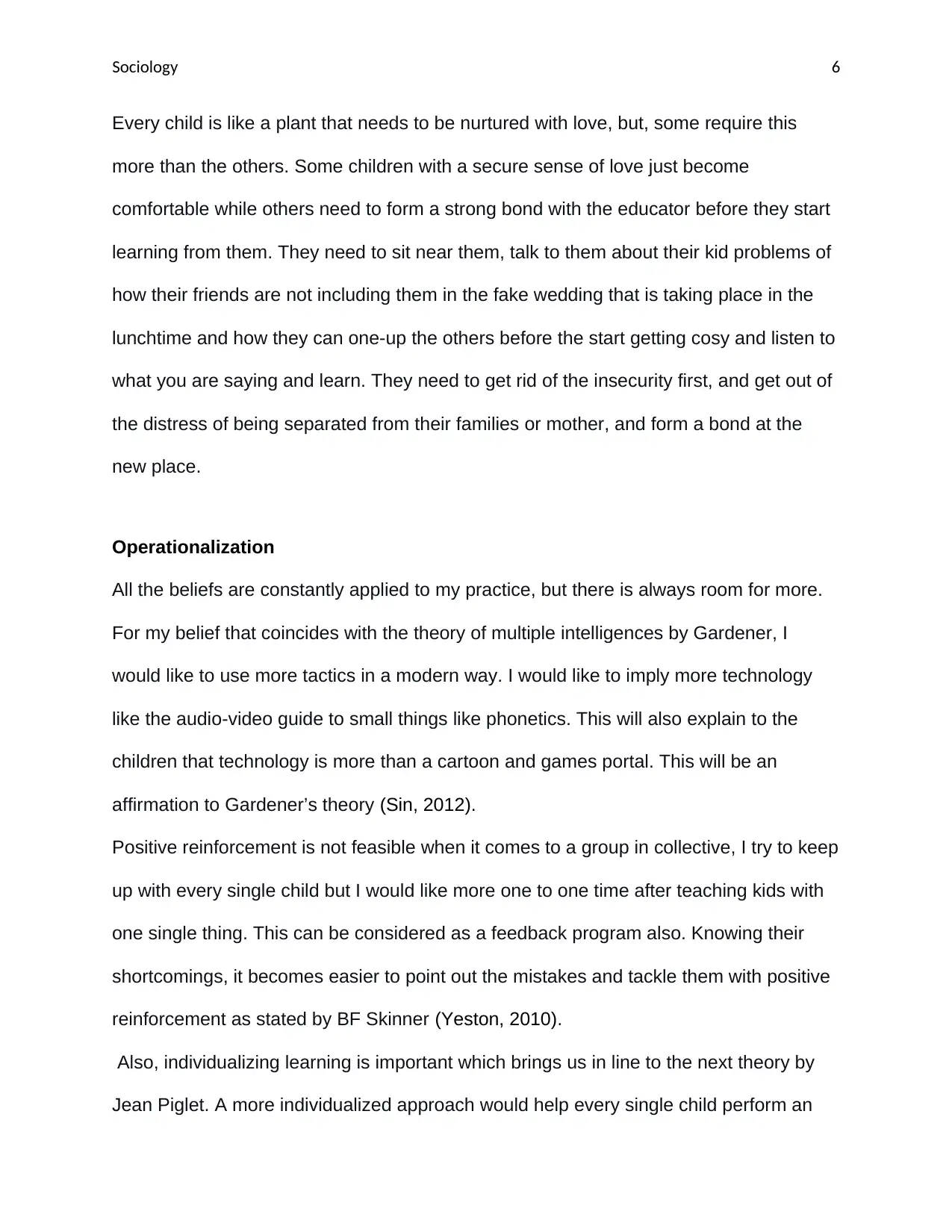
Sociology 6
Every child is like a plant that needs to be nurtured with love, but, some require this
more than the others. Some children with a secure sense of love just become
comfortable while others need to form a strong bond with the educator before they start
learning from them. They need to sit near them, talk to them about their kid problems of
how their friends are not including them in the fake wedding that is taking place in the
lunchtime and how they can one-up the others before the start getting cosy and listen to
what you are saying and learn. They need to get rid of the insecurity first, and get out of
the distress of being separated from their families or mother, and form a bond at the
new place.
Operationalization
All the beliefs are constantly applied to my practice, but there is always room for more.
For my belief that coincides with the theory of multiple intelligences by Gardener, I
would like to use more tactics in a modern way. I would like to imply more technology
like the audio-video guide to small things like phonetics. This will also explain to the
children that technology is more than a cartoon and games portal. This will be an
affirmation to Gardener’s theory (Sin, 2012).
Positive reinforcement is not feasible when it comes to a group in collective, I try to keep
up with every single child but I would like more one to one time after teaching kids with
one single thing. This can be considered as a feedback program also. Knowing their
shortcomings, it becomes easier to point out the mistakes and tackle them with positive
reinforcement as stated by BF Skinner (Yeston, 2010).
Also, individualizing learning is important which brings us in line to the next theory by
Jean Piglet. A more individualized approach would help every single child perform an
Every child is like a plant that needs to be nurtured with love, but, some require this
more than the others. Some children with a secure sense of love just become
comfortable while others need to form a strong bond with the educator before they start
learning from them. They need to sit near them, talk to them about their kid problems of
how their friends are not including them in the fake wedding that is taking place in the
lunchtime and how they can one-up the others before the start getting cosy and listen to
what you are saying and learn. They need to get rid of the insecurity first, and get out of
the distress of being separated from their families or mother, and form a bond at the
new place.
Operationalization
All the beliefs are constantly applied to my practice, but there is always room for more.
For my belief that coincides with the theory of multiple intelligences by Gardener, I
would like to use more tactics in a modern way. I would like to imply more technology
like the audio-video guide to small things like phonetics. This will also explain to the
children that technology is more than a cartoon and games portal. This will be an
affirmation to Gardener’s theory (Sin, 2012).
Positive reinforcement is not feasible when it comes to a group in collective, I try to keep
up with every single child but I would like more one to one time after teaching kids with
one single thing. This can be considered as a feedback program also. Knowing their
shortcomings, it becomes easier to point out the mistakes and tackle them with positive
reinforcement as stated by BF Skinner (Yeston, 2010).
Also, individualizing learning is important which brings us in line to the next theory by
Jean Piglet. A more individualized approach would help every single child perform an
Paraphrase This Document
Need a fresh take? Get an instant paraphrase of this document with our AI Paraphraser
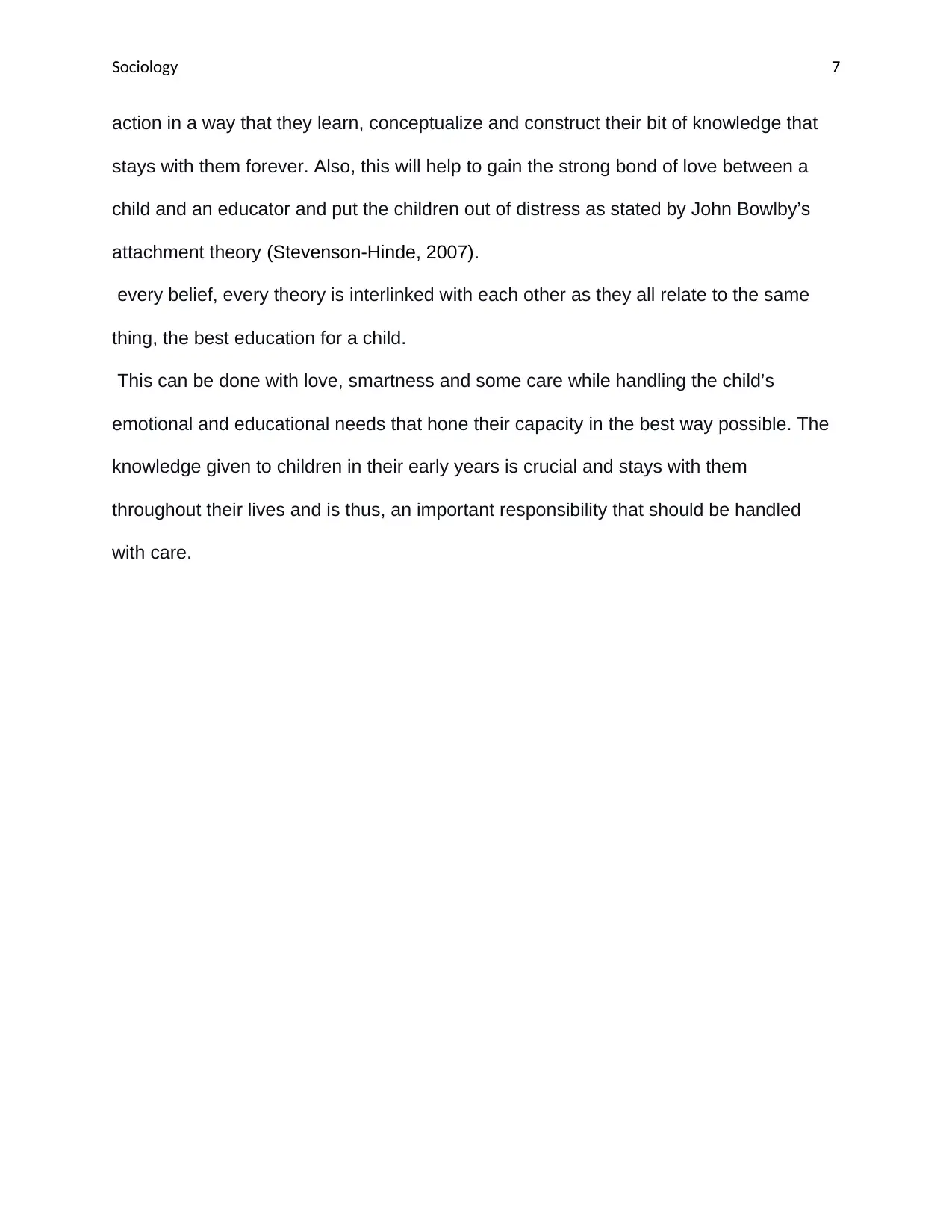
Sociology 7
action in a way that they learn, conceptualize and construct their bit of knowledge that
stays with them forever. Also, this will help to gain the strong bond of love between a
child and an educator and put the children out of distress as stated by John Bowlby’s
attachment theory (Stevenson-Hinde, 2007).
every belief, every theory is interlinked with each other as they all relate to the same
thing, the best education for a child.
This can be done with love, smartness and some care while handling the child’s
emotional and educational needs that hone their capacity in the best way possible. The
knowledge given to children in their early years is crucial and stays with them
throughout their lives and is thus, an important responsibility that should be handled
with care.
action in a way that they learn, conceptualize and construct their bit of knowledge that
stays with them forever. Also, this will help to gain the strong bond of love between a
child and an educator and put the children out of distress as stated by John Bowlby’s
attachment theory (Stevenson-Hinde, 2007).
every belief, every theory is interlinked with each other as they all relate to the same
thing, the best education for a child.
This can be done with love, smartness and some care while handling the child’s
emotional and educational needs that hone their capacity in the best way possible. The
knowledge given to children in their early years is crucial and stays with them
throughout their lives and is thus, an important responsibility that should be handled
with care.

Sociology 8
References
Cahan, J., 2018. National identity and the limits of constructivism in international
relations theory: a case study of the Suez Canal. Nations and Nationalism, 25(2),
pp.478-498.
Chongde, L. and Tsingan, L., 2003. Multiple Intelligence and the Structure of
Thinking. Theory & Psychology, 13(6), pp.829-845.
Del Giudice, M. and Belsky, J., 2010. Evolving Attachment Theory: Beyond Bowlby and
Back to Darwin. Child Development Perspectives, 4(2), pp.112-113.
Gillis, T., Janes, A. and Kaufman, M., 2012. Positive Reinforcement Training in Squirrel
Monkeys Using Clicker Training. American Journal of Primatology, 74(8), pp.712-
720.
Mantiri, O., 2013. Is Multiple Intelligence Theory Relevant in Teaching Today?. SSRN
Electronic Journal,.
Nevin, J. and Mandell, C., 2017. Comparing positive and negative reinforcement: A
fantasy experiment. Journal of the Experimental Analysis of Behavior, 107(1),
pp.34-38.
Park, S. and Song, M., 2012. Applying Multiple Intelligence Theory on the Multiple
Intelligence of Children. Journal of Digital Design, 12(4), pp.547-557.
Sangsawang, T., 2017. Constructivism perspective on multimedia games for hearing
impaired children. New Trends and Issues Proceedings on Humanities and Social
Sciences, 03(07), pp.100-108.
References
Cahan, J., 2018. National identity and the limits of constructivism in international
relations theory: a case study of the Suez Canal. Nations and Nationalism, 25(2),
pp.478-498.
Chongde, L. and Tsingan, L., 2003. Multiple Intelligence and the Structure of
Thinking. Theory & Psychology, 13(6), pp.829-845.
Del Giudice, M. and Belsky, J., 2010. Evolving Attachment Theory: Beyond Bowlby and
Back to Darwin. Child Development Perspectives, 4(2), pp.112-113.
Gillis, T., Janes, A. and Kaufman, M., 2012. Positive Reinforcement Training in Squirrel
Monkeys Using Clicker Training. American Journal of Primatology, 74(8), pp.712-
720.
Mantiri, O., 2013. Is Multiple Intelligence Theory Relevant in Teaching Today?. SSRN
Electronic Journal,.
Nevin, J. and Mandell, C., 2017. Comparing positive and negative reinforcement: A
fantasy experiment. Journal of the Experimental Analysis of Behavior, 107(1),
pp.34-38.
Park, S. and Song, M., 2012. Applying Multiple Intelligence Theory on the Multiple
Intelligence of Children. Journal of Digital Design, 12(4), pp.547-557.
Sangsawang, T., 2017. Constructivism perspective on multimedia games for hearing
impaired children. New Trends and Issues Proceedings on Humanities and Social
Sciences, 03(07), pp.100-108.
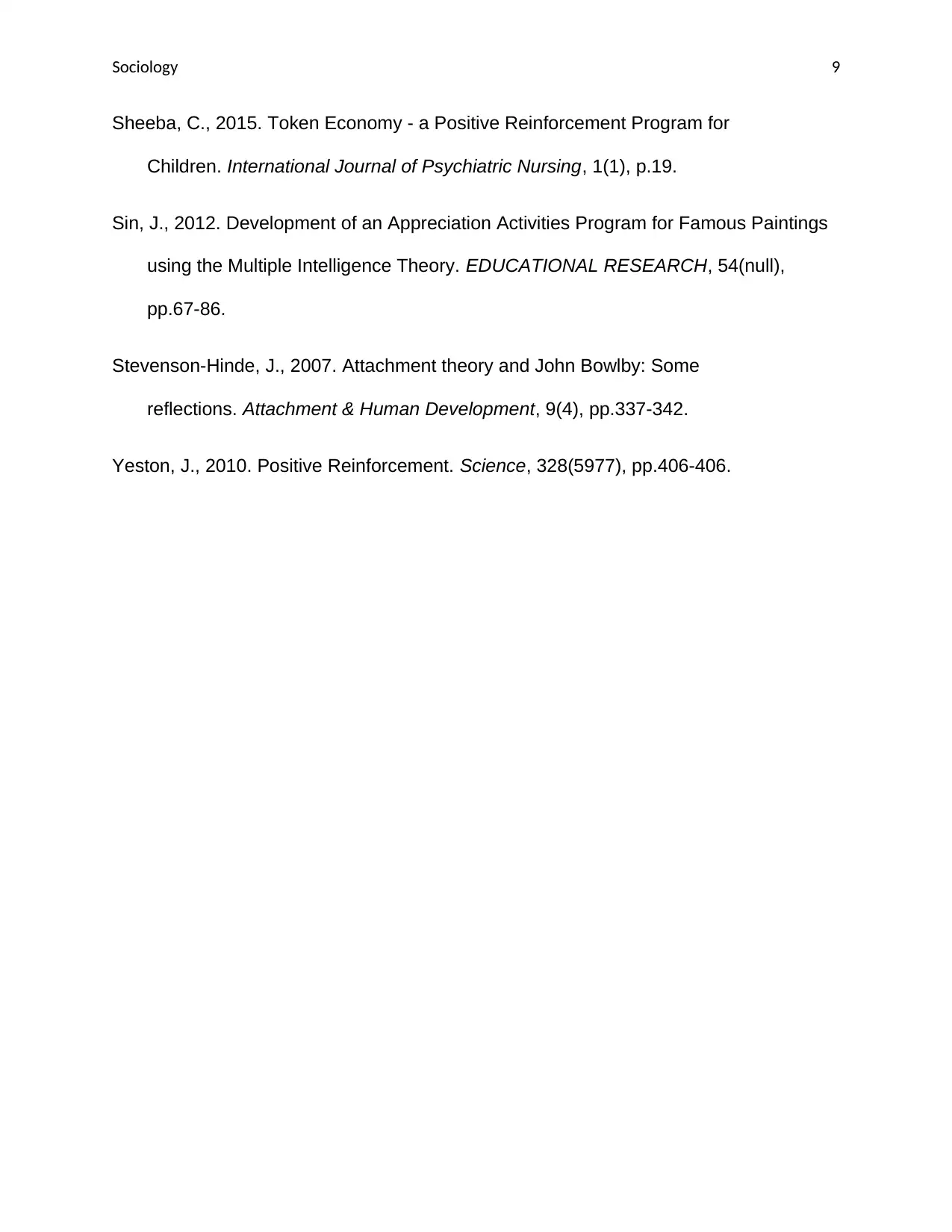
Sociology 9
Sheeba, C., 2015. Token Economy - a Positive Reinforcement Program for
Children. International Journal of Psychiatric Nursing, 1(1), p.19.
Sin, J., 2012. Development of an Appreciation Activities Program for Famous Paintings
using the Multiple Intelligence Theory. EDUCATIONAL RESEARCH, 54(null),
pp.67-86.
Stevenson-Hinde, J., 2007. Attachment theory and John Bowlby: Some
reflections. Attachment & Human Development, 9(4), pp.337-342.
Yeston, J., 2010. Positive Reinforcement. Science, 328(5977), pp.406-406.
Sheeba, C., 2015. Token Economy - a Positive Reinforcement Program for
Children. International Journal of Psychiatric Nursing, 1(1), p.19.
Sin, J., 2012. Development of an Appreciation Activities Program for Famous Paintings
using the Multiple Intelligence Theory. EDUCATIONAL RESEARCH, 54(null),
pp.67-86.
Stevenson-Hinde, J., 2007. Attachment theory and John Bowlby: Some
reflections. Attachment & Human Development, 9(4), pp.337-342.
Yeston, J., 2010. Positive Reinforcement. Science, 328(5977), pp.406-406.
1 out of 10
Your All-in-One AI-Powered Toolkit for Academic Success.
+13062052269
info@desklib.com
Available 24*7 on WhatsApp / Email
![[object Object]](/_next/static/media/star-bottom.7253800d.svg)
Unlock your academic potential
© 2024 | Zucol Services PVT LTD | All rights reserved.


